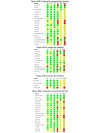Zinc supplementation for acute and persistent watery diarrhoea in children: A systematic review and meta-analysis
- PMID: 39641338
- PMCID: PMC11622351
- DOI: 10.7189/jogh.14.04212
Zinc supplementation for acute and persistent watery diarrhoea in children: A systematic review and meta-analysis
Abstract
Background: Zinc is a micronutrient that plays a role in immune system strengthening and regulation of intestinal epithelial cells, and can reduce the duration and severity of diarrhoea. We conducted a systematic review of randomised controlled trials (RCTs) to assess the effectiveness of zinc compared to no zinc for the management of acute and persistent diarrhoea in children.
Methods: We searched PubMed, the Cochrane Library, Scopus, CINAHL, ClinicalTrials.gov, and World Health Organization (WHO) International Clinical Trials Registry Platform from inception until 31 July 2023 for studies published from year 2000 onwards that assessed the use of zinc in the management of acute and persistent diarrhoea in children aged less than 10 years. We conducted the meta-analysis in Cochrane's RevMan software, determined risk of bias in individual studies using the Risk of Bias 2 (RoB 2) tool, and assessed the quality of evidence through the Grading of Recommendations Assessment, Development and Evaluation (GRADE) approach. This review was commissioned by the WHO for revision of their guidelines for childhood diarrhoea management.
Results: We included 38 RCTs in this systematic review. Our findings suggest that, in children with acute diarrhoea, zinc supplementation resulted in a greater proportion of children who recovered from diarrhoea at last follow-up (risk ratio (RR) = 1.07; 95% confidence interval (CI) = 1.03, 1.1; moderate certainty of evidence) and a reduction in the duration of diarrhoea (mean difference (MD) = -13.27 hours; 95% CI = -17.66, -8.89; moderate certainty of evidence) when compared to placebo. A significant number of children in the zinc group compared to placebo experienced vomiting (RR = 1.46; 95% CI = 1.22, 1.76; moderate certainty of evidence), however, there were few vomiting episodes in low-dose zinc group compared to high-dose (RR = 0.80; 95% CI = 0.72, 0.89; moderate certainty of evidence). In children with persistent diarrhoea, zinc supplementation led to a greater proportion of children who recovered from diarrhoea (RR = 1.75; 95% CI = 1.34, 2.30; low certainty of evidence). The low certainty of evidence ratings were mostly due to high heterogeneity among the studies.
Conclusions: Zinc should continue to be recommended in children under the age of 10 years with acute or persistent diarrhoea, but moderate certainty of evidence concludes that the dose of zinc should be reduced. However, further multi-country randomised clinical trials are required with a direct comparison to assess the appropriate dosage, duration and adverse effects.
Registration: PROSPERO: CRD42023439028.
Copyright © 2024 by the Journal of Global Health. All rights reserved.
Conflict of interest statement
Disclosure of interests: The authors completed the ICMJE Disclosure of Interest Form (available upon request from the corresponding author) and disclose the following activities and/or relationships: YBN is staff member of the World Health Organization.
Figures







References
-
- Unite Nations Children’s Fund. Diarrhoea. 2024. Available: https://data.unicef.org/topic/child-health/diarrhoeal-disease/. Accessed: 19 November 2024.
-
- World Health Organization. Diarrhoeal disease. Available: https://www.who.int/news-room/fact-sheets/detail/diarrhoeal-disease. Accessed: 19 November 2024.
-
- Widayati P, Rahardjo SS, Widyaningsih V.Meta-Analysis on the Effect of Zinc on Reducing Diarrhea Episode in Toddlers. Indonesian Journal of Medicine. 2019;4:183–91. 10.26911/theijmed.2019.04.02.12 - DOI
-
- Deichsel EL, Keita AM, Verani JR, Powell H, Jamka LP, Hossain MJ, et al. Management of diarrhea in young children in sub-Saharan Africa: adherence to World Health Organization recommendations during the global enteric multisite study (2007–2011) and the Vaccine Impact of Diarrhea in Africa (VIDA) Study (2015–2018). Clin Infect Dis. 2023;76:S23–31. 10.1093/cid/ciac926 - DOI - PMC - PubMed
Publication types
MeSH terms
Substances
Grants and funding
LinkOut - more resources
Full Text Sources
Medical
